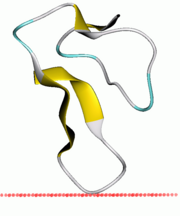AgRP je parakrini signalni molekul koji se sastoji od 132 aminokiseline. Njega su nezavisno identifikovala dva tima 1997. na osnovu sličnosti njegove sekvence sa aguti signalnim peptidom (ASIP), proteinom koji se sintetiše u koži i kontroliše boju dlake.[4][5] AgRP je aproksimativno 25% identičan sa ASIP. Mišji homolog AgRP peptida se sastoji od 131 aminokiseline i ima 81% identičnih aminokiselina sa humanim proteinom. Biohemijske studije indiciraju da je AgRP veoma stabilan u pogledu termalne denaturacije i kiselinske degradacije. Njegova sekundarna struktura sadrži uglavnom randomne zavoje i β-ravni.[6] AgRP je nalazi na humanom hromozomu 16q22, i mišjem hromozomu 8D1-D2.
- ↑ Bäckberg M, Madjid N, Ogren SO, Meister B (June 2004). „Down-regulated expression of agouti-related protein (AGRP) mRNA in the hypothalamic arcuate nucleus of hyperphagic and obese tub/tub mice”. Brain Res. Mol. Brain Res. 125 (1-2): 129–39. DOI:10.1016/j.molbrainres.2004.03.012. PMID 15193430.
- ↑ Shutter JR, Graham M, Kinsey AC, Scully S, Lüthy R, Stark KL (March 1997). „Hypothalamic expression of ART, a novel gene related to agouti, is up-regulated in obese and diabetic mutant mice”. Genes Dev. 11 (5): 593–602. DOI:10.1101/gad.11.5.593. PMID 9119224.
- ↑ Ollmann MM, Wilson BD, Yang YK, Kerns JA, Chen Y, Gantz I, Barsh GS (October 1997). „Antagonism of central melanocortin receptors in vitro and in vivo by agouti-related protein”. Science 278 (5335): 135–8. DOI:10.1126/science.278.5335.135. PMID 9311920.
- ↑ Shutter JR, Graham M, Kinsey AC, Scully S, Lüthy R, Stark KL (March 1997). „Hypothalamic expression of ART, a novel gene related to agouti, is up-regulated in obese and diabetic mutant mice”. Genes & Development 11 (5): 593–602. DOI:10.1101/gad.11.5.593. PMID 9119224.
- ↑ Ollmann MM, Wilson BD, Yang YK, Kerns JA, Chen Y, Gantz I, Barsh GS (October 1997). „Antagonism of central melanocortin receptors in vitro and in vivo by agouti-related protein”. Science 278 (5335): 135–8. DOI:10.1126/science.278.5335.135. PMID 9311920.
- ↑ Rosenfeld RD, Zeni L, Welcher AA, Narhi LO, Hale C, Marasco J, Delaney J, Gleason T, Philo JS, Katta V, Hui J, Baumgartner J, Graham M, Stark KL, Karbon W (November 1998). „Biochemical, biophysical, and pharmacological characterization of bacterially expressed human agouti-related protein”. Biochemistry 37 (46): 16041–52. DOI:10.1021/bi981027m. PMID 9819197.
Literatura
uredi
- Dhillo WS, Gardiner JV, Castle L, Bewick GA, Smith KL, Meeran K, Todd JF, Ghatei MA, Bloom SR (December 2005). „Agouti related protein (AgRP) is upregulated in Cushing's syndrome”. Exp. Clin. Endocrinol. Diabetes 113 (10): 602–6. DOI:10.1055/s-2005-872895. PMID 16320160. Arhivirano iz originala na datum 2011-08-15. Pristupljeno 2014-04-21.
- Dinulescu DM, Cone RD (March 2000). „Agouti and agouti-related protein: analogies and contrasts”. J. Biol. Chem. 275 (10): 6695–8. DOI:10.1074/jbc.275.10.6695. PMID 10702221.
- Scarlett JM, Zhu X, Enriori PJ, Bowe DD, Batra AK, Levasseur PR, Grant WF, Meguid MM, Cowley MA, Marks DL (October 2008). „Regulation of agouti-related protein messenger ribonucleic acid transcription and peptide secretion by acute and chronic inflammation”. Endocrinology 149 (10): 4837–45. DOI:10.1210/en.2007-1680. PMC 2582916. PMID 18583425.
- Creemers JW, Pritchard LE, Gyte A, Le Rouzic P, Meulemans S, Wardlaw SL, Zhu X, Steiner DF, Davies N, Armstrong D, Lawrence CB, Luckman SM, Schmitz CA, Davies RA, Brennand JC, White A (April 2006). „Agouti-related protein is posttranslationally cleaved by proprotein convertase 1 to generate agouti-related protein (AGRP)83-132: interaction between AGRP83-132 and melanocortin receptors cannot be influenced by syndecan-3”. Endocrinology 147 (4): 1621–31. DOI:10.1210/en.2005-1373. PMID 16384863.
- Katsuki A, Sumida Y, Gabazza EC, Murashima S, Tanaka T, Furuta M, Araki-Sasaki R, Hori Y, Nakatani K, Yano Y, Adachi Y (May 2001). „Plasma levels of agouti-related protein are increased in obese men”. J. Clin. Endocrinol. Metab. 86 (5): 1921–4. DOI:10.1210/jc.86.5.1921. PMID 11344185.
- Kas MJ, Bruijnzeel AW, Haanstra JR, Wiegant VM, Adan RA (August 2005). „Differential regulation of agouti-related protein and neuropeptide Y in hypothalamic neurons following a stressful event”. J. Mol. Endocrinol. 35 (1): 159–64. DOI:10.1677/jme.1.01819. PMID 16087729.
- Jackson PJ, Yu B, Hunrichs B, Thompson DA, Chai B, Gantz I, Millhauser GL (October 2005). „Chimeras of the agouti-related protein: insights into agonist and antagonist selectivity of melanocortin receptors”. Peptides 26 (10): 1978–87. DOI:10.1016/j.peptides.2004.12.036. PMID 16009463.
- Bäckberg M, Madjid N, Ogren SO, Meister B (June 2004). „Down-regulated expression of agouti-related protein (AGRP) mRNA in the hypothalamic arcuate nucleus of hyperphagic and obese tub/tub mice”. Brain Res. Mol. Brain Res. 125 (1-2): 129–39. DOI:10.1016/j.molbrainres.2004.03.012. PMID 15193430.
- http://zootekni.comu.edu.tr/a_kadro/yayin/pala/agouti%20pakistan.pdf Arhivirano 2011-10-09 na Wayback Machine-u
- http://www.endotext.org/obesity/obesity5/obesity5.htm Arhivirano 2011-06-16 na Wayback Machine-u
Spoljašnje veze
uredi
